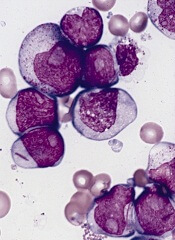
New research suggests the protein SAMHD1 could be used to predict which
patients with acute myeloid leukemia (AML) will respond to treatment
with cytarabine.
Researchers found that response to cytarabine
was inversely correlated with SAMHD1 expression in AML cell lines, mouse
models of the disease, and adult patients with AML.
Jindrich Cinatl, PhD, of the University of Frankfurt in Germany, and his colleagues reported these findings in Nature Medicine.
The researchers first analyzed 13 AML cell lines and found that SAMHD1 reduces the cytotoxic effect of cytarabine. When the team depleted SAMHD1 in these cell lines, they were “markedly sensitized” to cytarabine.
The researchers also cultivated cytarabine-resistant AML cell lines and found that SAMHD1 levels increased along with cytarabine resistance. However, depleting SAMHD1 resensitized the cells to cytarabine.
Investigation revealed that SAMHD1 removes the phosphate residues from the active form of cytarabine, Ara-CTP, and converts the drug to its inactive form, Ara-C.
The researchers then evaluated the role of SAMHD1 in AML in vivo. They transplanted SAMHD1-knockout AML cells and wild-type SAMHD1 AML cells into mice and treated the mice with cytarabine or phosphate-buffered saline.
Mice that received SAMHD1-knockout AML cells and cytarabine had significantly longer survival than mice that received wild-type SAMHD1 AML cells and cytarabine or either AML cell type plus phosphate-buffered saline.
Next, the researchers tested blasts isolated from the bone marrow of patients with therapy-naive AML.
The team found that basal SAMHD1 expression was significantly correlated with cytarabine IC50 values. And depleting SAMHD1 diminished cytarabine IC50 values by 3- to 15-fold.
Lastly, the researchers assessed whether SAMHD1 expression might be used to predict response to cytarabine-based therapy in patients with AML.
The team analyzed a cohort of 150 adult AML patients who had received 1 to 2 courses of induction therapy including cytarabine—either 2 cycles of 7+3 or 7+3 plus high-dose cytarabine in combination with mitoxantrone.
Analysis revealed that SAMHD1 expression was “markedly increased” among patients who did not achieve a complete remission (CR) at the end of induction.
Of the 112 patients who achieved a CR, 90 were scored as “SAMHD1 low,” and 22 were scored as “SAMHD1 high.” The CR rate was 44% in the SAMHD1-high cohort and 90% in the SAMHD1-low cohort.
In addition, the researchers found the level of SAMHD1 expression in blasts at patients’ initial diagnosis was predictive of event-free survival, relapse-free survival, and overall survival.
The team said these results suggest SAMHD1 could be used to guide treatment with cytarabine-based therapies in patients with AML.


